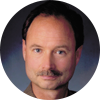In those days, my own vocabulary extended beyond enthesopathy to include stock options, founders' shares, capitalization, company valuations, click-throughs, exit strategies, investing, vesting and divesting. Everyone was prowling for the "killer application." The "killer app" was an infrastructure (like plumbing, everyone needs it); a "new-new" thing irresistible to geeks and consumers. Innovation was God, but bad ideas were everywhere. The Internet was a seductive power looking for a purpose. The best idea the cutting edge could come up with was to sell stuff cheaper and faster, pushed by huge advertising budgets. A 30-second Super Bowl commercial could pay the utility bills of a small American city for a month, and a new gold rush was on - but where was the gold?
My high-minded great-great grandfather, the Reverend James Monroe Crawford, was a Presbyterian minister in 1850s San Francisco during the first Gold Rush era. His thankless job was to keep people from losing their souls to the temptation brought about by gold. But what were we rushing for in 1999? Gadgets and gizmos, knowledge, expertise - or something else?
Under all the glitter and caffeine, the new rush was most likely to find expertise, minds or people. Except for BMWs, machines were a mere artifact of the industrial age. Someone declared that a business' valuation could no longer be a mere sum of its building, equipment, cash and A/R. It would need to include people. Without the enthusiasm, skill, love for work, diligence, intelligence and health of its employees, there were no lofty corporate missions, sales or successful enterprises. Fortunes collapsed when bright minds got wrapped up in big egos and left for better offers, and no less than the Harvard Business Review published monthly articles extolling the bottom-line sense in taking care of employees for better productivity and fewer sick days. Health plans came under fire. The neat managed care trick of shifting risk to physicians had failed. Health care costs were again reaching escape velocity.
At the same time, alternative medicines was fighting for its place in health care and reimbursement. An admiring public was forcing the issue. It turns out those same smart, educated "assets" powering the new economy also wanted access to chiropractors, acupuncturists and massage therapists. They wanted informed health care choices.
This confluence of human assets and alternative medicine added up to a pregnant possibility: a revolution in health care. Alternative medicine and better self-care were opportunities to reduce the medicalization of health. Health = happier and more productive employees = reduced health care costs. Sickness was not just an insurance problem; it was a productivity problem.
Who has the solid foundation in health care education to advise people with credible information? Who has the professional capacity? Chiropractors may be uniquely qualified for the task. All health care professions treat the sick, but the chiropractic perspective is notably different. In a powerful, yet almost invisible way, chiropractors think that, given the opportunity, living things gravitate to health. Health is an inside job sometimes needing a little help.
If chiropractors wanted to play in this new game, additional training would be necessary in domains such as integrated patient-care advocacy, ergonomics, health promotion, health coaching, prevention, motivation, disability management, chronic illness care, geriatric care, and behavioral and public health. The DC degree would be a "first-degree black belt" to be built upon.
Life force can be choked off by the subluxations (ignorance, apathy, aberrations and neglect) of life behaviors, expressed in chronic stress, obesity, hypertension and diabetes. Given proper training, the chiropractor could become a specialist in human asset management for the knowledge economy. The directive would be to make better employees (not loyal patients); and true health care practiced by teaching, consulting, and guiding people back to the basics.
When the bubble burst, this dream did not die. As with so many spectacular failures, a fundamental wisdom was acquired: Regardless of service or industry, people are the main assets. An unhealthy workforce is a terrible economic liability. Nonetheless, employers still struggle today with double-digit annual increases in health care costs. And if you don't think that is a problem, figure that premiums can double every three to four years at that rate. Chiropractors can be a part of the solution. Cross-trained in corporate health promotion, public health, and behavioral health, chiropractic can be the "killer app" that heals.
As we all know, health maintenance organizations never maintained health - but chiropractic health coaches could. The inefficient world of health care will reject the push to sell more clinical services; it needs better outcomes with lower cost. Selling the "innate" chiropractic wisdom for prevention and management of illness is the future. There can and should be great rewards for reducing health care costs. Chiropractors can actually take the lead in health care reform.
Talk to the small-to-medium-sized employers looking for relief and happier employees, and desperately trying to contain health care costs. Don't try to sell them on chiropractic. Just listen carefully, and they will tell you what they need, and where health care and benefits must go. You will be surprised at how many solutions you already have for them!
J. Michael Menke, DC
Palo Alto, California
Click here for previous articles by J. Michael Menke, MA, DC, PhD.





